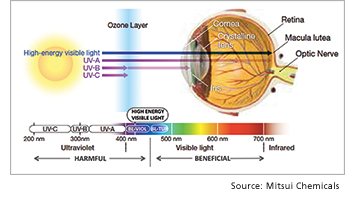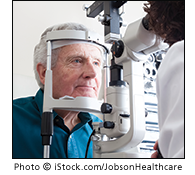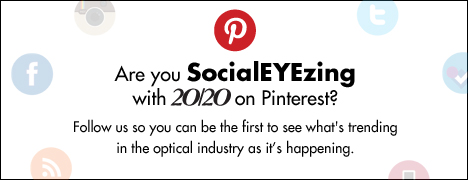|
Your monthly guide to staff training outside the box
Eyes / Lenses / Fitting Lenses / Free-Form / Frames / Sunwear / Patient Solutions/ In-office / Standards
LENSES: Good UV Good Blue, Bad UV Bad Blue
EYES OVEREXPOSED
The Vision Council released a new report in January 2016 titled, “Eyes Overexposed, a Digital Device Dilemma” (visit thevisioncouncil.org). As the report teaches, discomfort and the symptoms of blurred vision and fatigue are of course, temporary.
The report effectively describes ways to reduce digital eyestrain with proximity, frequency, time used and general body posture recommendations, as well as getting unplugged, as unlikely as that may seem. The report then highlights what is not temporary: “Preliminary research points to a potential long-term hazard from the effects of too much screen time: consistent exposure to HEV, or blue light, may be linked to long-term vision issues such as age-related macular degeneration (AMD) and cataracts. (From Experimental Eye Research, “Transmission of Light to the Aging Human Retina: Possible Implications for Age Related Macular Degeneration,” December 2004)
While blue light, high-energy visible radiation is of concern for electronic device use, that same radiation is also part of sunlight in our everyday outdoor environment. And like UV radiation, the effects of HEV can be accumulated in retinal tissue. That suggests we consider outdoor methods to effectively reduce these hazardous wavelengths, as well as reduce potentially hazardous HEV wavelengths indoors and at night.
See Plus »
|
GOOD UV
The cumulative effects of ultraviolet radiation (UVR) have been implicated as a cause of cataracts, keratitis, pingueculae, pterygia, various eye and skin cancers, wrinkles, as well as age-related macular degeneration. However, UVR can also be good since it aids in production of vitamin D, and its major source is exposure to the sun. Lack of sun exposure and vitamin D deficiency (a worldwide health problem) have been linked to many serious chronic diseases, including autoimmune, infectious and cardiovascular disorders, as well as cancers. Recent studies have suggested that the components of vitamin D production are beneficial as anticancer agents in the body. Though there is a contradiction here, we believe that with the right information about UV, every eyecare professional (ECP) can provide a balanced plan for every patient.
See Plus »
|
|


|
TIME TO RELOAD ON SUNGLASSES
It’s an ideal time to bring additional sunglasses into your stock. It is the time of year people are planning vacations; they are spending more time outside at sporting events and exercising, and the amount of time people are around water (pools, lakes and oceans) increases considerably. It’s time to be prepared for all of your patients’ needs and wants at your fingertips. And it’s for more reasons than just a fashion trend. The protection and safety needs of sunglasses are a must for all opticians to understand and be able to educate patients about keeping their eyes safe from damaging UV and HEV light.
See Plus »
|
BRIGHT BLUE SKY

On a sunny day our life is lit up with blue. The bright blue sky is spread out like a cheerful canopy above us. We need some of the natural blue light it bestows upon us since it serves as a biological reminder to our bodies that it is daytime. It also makes us feel alert, happy, energized and awake, and adds to our color perception. However, exposure to artificial blue light at the wrong time of day can negatively impact our sleep cycle, and recent studies have shown that a particular type of blue light found in natural and artificial light known as High Energy Visible or blue-violet light can wreak havoc on our eye health.
See Plus »
|
PROTECTING THE RETINA
The retina is exquisitely sensitive to light. The rods are able to detect motion and assemble the visual scene with very little light for night vision, while the cones provide exceptional clarity and colors when there is sufficient light. These structures are also terribly sensitive to the toxic effects of UV and HEV. While the cornea and lens protect the retina from this radiation, except as a child, excesses of both continually bombard our eyes. As a result, protection of the retina is required throughout life. UV is implicated in age-related macular degeneration (AMD) due to high exposure to UV over a lifetime.
AMD is the major cause of vision impairment in the over 50 group in the U.S., and its prevalence is expected to increase as the number of those over 60 increases. Newer research about the effects of HEV, in particular the wavelengths centered around 430 nm (±20 nm) also show that this blue light plays a role in the incidence and severity of AMD. In both cases, free radical damage to the cells of the retina by UV and HEV is suggested. See the videos prepared by the National Eye Institute.
See Plus »
|
GOOD BLUE
One of the benefits of blue light is that it helps to regulate our sleeping pattern because its presence suppresses melatonin production. Melatonin is a hormone that makes our bodies drowsy and ready for sleep. In the absence of blue light, specialized cells in our retina called intrinsically photosensitive retinal ganglion cells (ipRGCs) become switched on. When they are activated, they send a signal to the brain telling the pineal gland to start the process of melatonin production. When melatonin is produced in our bodies, it lets us know it’s time for rest. If it is produced at a particular time on a regular basis, our sleep cycle and circadian rhythm become set to that time. We wouldn’t want all blue light to be blocked completely because then we would not receive any stimulation from blue light, like that of the bright blue sky, telling our bodies when it is daytime and when it is nighttime.
See Plus »
|
TRUSTED EYECARE EXPERTS

First, recommend to all customers that they get a comprehensive dilated eye exam annually especially if over the age of 50. The early detection of age-related eye diseases can ensure treatment when it is most important. A dilated exam also lets the eyecare professional see the effects of systemic diseases like diabetes and high blood pressure or AMD that only a refraction would miss.
Next, attenuate the most UV and HEV radiation possible, indoors and outdoors. In order to do this, knowledge of lens attributes as it relates to radiation attenuation is required.
Modern lenses should attenuate UV and HEV using all the properties of the lens, i.e., coatings on the front, lens material, polarizing films, photochromics and the coating applied to the back. The frame should fit well and provide good coverage, and minimize the UV and HEV getting to the eye from the top and sides. Usually in outdoor eyewear, that means that the closer the fit and the more wrapped the frame, the better the coverage.
See Plus »
|
|


|
|